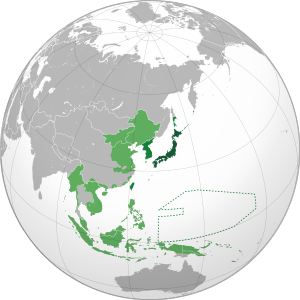State Shinto
[1]: 547 The state exercised control of shrine finances and training regimes for priests[2][3]: 59 [4]: 120 to strongly encourage Shinto practices that emphasized the Emperor as a divine being.
[6]: 115 Imperial scholars believed Shinto reflected the historical fact of the Emperor's divine origins rather than a religious belief, and argued that it should enjoy a privileged relationship with the Japanese state.
[5]: 8 [3]: 59 The government argued that Shinto was a non-religious moral tradition and patriotic practice, to give the impression that they supported religious freedom.
[2]: 428 [10]: 706 [11] Shinto is a blend of indigenous Japanese folk practices, beliefs, court manners, and spirit-worship which dates back to at least 600 CE.
[7]: 99 These beliefs were unified as "Shinto" during the Meiji era (1868–1912),[6]: 4 [12] though the Chronicles of Japan (日本書紀, Nihon Shoki) first referenced the term in the eighth century.
[6]: 133 [7]: 97 By declining to ban Shinto practices outright, Japan's post-war constitution was able to preserve full freedom of religion.
[7]: 100 The extent to which Emperor worship was supported by the population is unclear, though scholars such as Ashizu Uzuhiko, Sakamoto Koremaru, and Nitta Hitoshi argue that the government's funding and control of shrines was never adequate enough to justify a claim to the existence of a State Shinto.
[5]: 8 [3]: 59 By establishing Shinto as a unique form of "suprareligious" cultural practice, it would be exempted from Meiji laws protecting freedom of religion.
"[6]: 66 Rather than a religious practice, Shinto was understood as a form of education, which "consists of the traditions of the imperial house, beginning in the age of gods and continuing through history.
[20] The Empire of Japan endeavored, through education initiatives and specific financial support for new shrines, to frame Shinto practice as a patriotic moral tradition.
[4]: 120 From the early Meiji era, the divine origin of the Emperor was the official position of the state, and taught in classrooms not as myth, but as historical fact.
[4]: 120 State Shinto practitioners also emphasized the ritual aspect as a traditional civic practice that did not explicitly call on faith to participate.
[3]: 59 By balancing a "suprareligious" understanding of Shinto as the source of divinity for both Japan and the Emperor, the state was able to compel participation in rituals from Japanese subjects while claiming to respect their freedom of religion.
[22]: 15 In 1936, the Catholic Church's Propaganda Fide agreed with the state definition, and announced that visits to shrines had "only a purely civil value".
[6]: 23 A greater number of better-trained priests with educations at state-supported schools, combined with a rising patriotic fervor, is believed by some to have seeded an environment in which grassroots Emperor worship was possible, even without financial support for local shrines.
[6]: 113 [7] In 1913, official rules for Shrine priests — Kankokuheisha ika jinja shinshoku hömu kisoku (官国幣社以下神社神 職奉務規則) — specifically called upon "a duty to observe festivals conforming to the rituals of the state.
Up to that point, individual priests had been limited in their political roles, delegated to certain rituals and shrine upkeep, and rarely encouraged Emperor worship, or other aspects of state ideology, independently.
[6]: 66 Kokugaku was an Edo-period educational philosophy which sought a "pure" form of Japanese Shinto, stripped of foreign influences — particularly Buddhism.
[6]: 28 In the Meiji era, scholar Hirata Atsutane advocated for a return to "National Learning" as a way to eliminate the influence of Buddhism and distill a nativist form of Shinto.
[6]: 16 From 1868 to 1884, the disciples of Atsutane, along with other priests and scholars, lead a "Great Promulgation Campaign" advocating a fusion of nationalism and Shinto through worship of the Emperor.
[6]: 17 The state responded by passing the Kami and Buddhas Separation Order (神仏判然令, Shinbutsu Hanzenrei) in 1868 and pursuing a policy of Haibutsu kishaku to remove Buddhist influence[26] and re-establishing direct imperial control of the Department of Divinity ("jingikan") in 1869.
[6]: 17 [7]: 112 This government bureaucracy encouraged the segregation of Kami spirits from Buddhist ones, and emphasized the divine lineage of the Emperor from the Sun Goddess, Amaterasu.
Shinto, they argued, was a preservation of the traditions of the Imperial house and therefore represented the purest form of Japanese state rites.
The name Yasukuni, quoted from the phrase「吾以靖國也 in the classical-era Chinese text Zuo Zhuan (Scroll 6, 23rd Year of Duke Xi), literally means "Pacifying the Nation" and was chosen by the Meiji Emperor.
[35] In Manchuria, The Japanese conducted scholarly research on the local folk religion and built 366 Shrines, although without trying to impose Shinto on the native populations as it was the case in Korea and Taiwan, as the Manchurian State was conceived as a spiritually autonomous nation.
[citation needed] At least fifteen State Shinto shrines were established in the South Seas Mandate in the late 1920s and early 1930s.
[10]: 702 General Douglas MacArthur and the State Department sought to maintain the authority of the Emperor to avoid "lasting resentment" among the Japanese people during the occupation and reconstruction of Japan.
[5]: 39 Today, while the Imperial House continues to perform Shinto rituals as "private ceremonies", participation and belief are no longer obligatory for Japanese citizens, nor funded by the state.
[11] In contrast, the Meiji-era Yasukuni Shrine is frequently the target of State Shinto controversies, mostly owing to its enshrinement of Japanese war criminals.
[11] Conservative politicians and nationalist interest groups continue to advocate for returning the Emperor to a central political and religious position, which they believe will restore a national sense of unity.







